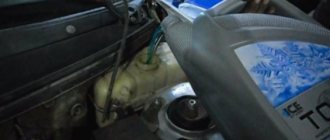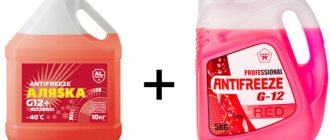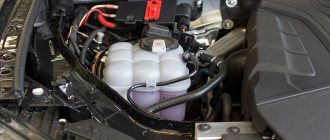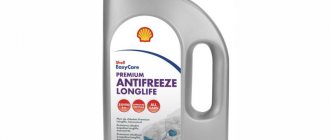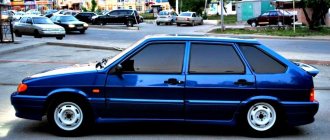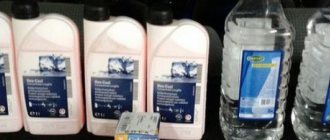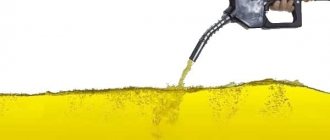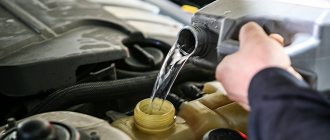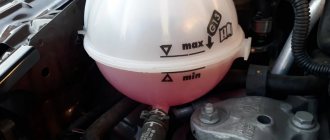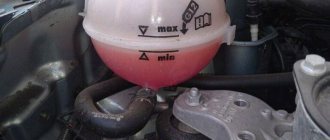I would like to note in advance that I have been using the car for many years and this time I will talk about the differences between 11th and 12th generation antifreezes. These types of antifreeze are among the most common on the market today.
I have first-hand information and write as a skilled and knowledgeable automotive expert who is responsible for the words and has tried various antifreezes in life. As I grew in the professional field, I learned to understand many engines and know the design of the motor inside out.
Let's start with the shade
What does the difference in shades mean between the antifreeze version G11 and the newer G12? The generally accepted classification of cooling mixtures in the automotive world was created at one time by Volkswagen in Europe. At that time, it was proposed to produce cooling mixtures of the so-called inorganic properties with advanced characteristics (G11) - blue and green antifreezes with numerous additives. Also organic antifreeze. origin (designated as G12) - usually produced in pink and red colors.
Important: this established shade system is used quite often, but still is not an established standard. In other words, there is practically nothing obliging companies to engage in such release of products to the market and somehow adhere to the technology.
Often manufacturing companies try to paint engine mixtures in a proprietary or specific shade. That is why, when choosing a new antifreeze for your engine, you should not pay attention to the shade, but simply consider the accepted product labeling.
The basis of each composition for cooling a motor of any type is a chemical base called ethylene glycol, or the base may be called propylene glycol. These substances can have a huge coefficient of so-called temperature increase, as well as a weak freezing point of the mixture. Among other things, the mixture for cooling the engine usually includes plain water and several additives for better service of the mixture for the benefit of the engine.
It is worth considering that manufacturing companies add additives to many types of G11 that can suppress the corrosion process during operation of the mixture. It also contains fluorescent additives and anti-foam additives with anti-cavitation additives.
5. “Lobrid” technology (S-OAT, P-OAT and others).
The intricate name is deciphered as low-hybrid, i.e. "low-hybrid" technology. That is, this is a combination of carboxylates with inorganic components, only there are significantly fewer inorganics there than in the hybrid technology. For example, in Volkswagen specification G 11 (hybrid technology) the amount of silicates is limited to 500-680 mg/l, and in specification G 12++ (lobrid technology) - 400-500 mg/l. What's the trick here? According to the logic of manufacturers, when poured into a new car, inorganic inhibitors cover the entire system with a thin layer, forming, so to speak, basic protection against corrosion. Since there are few of them, then
- firstly, they are consumed at the very beginning of work
- secondly, they do not have time to increase the thickness of the film, which means they slightly worsen heat transfer.
And after this, carboxylate inhibitors come into play, reacting to pockets of corrosion, which, naturally, will be fewer after pre-treatment with inorganics. Accordingly, carboxylates will last longer. As a result, antifreezes of Lobrid technology have a service life comparable to the service life of a car and are positioned by many manufacturers as “not requiring replacement.”
In different countries and different manufacturers, different compositions of inorganic inhibitors are possible, which is expressed in the abbreviated names of the technologies they use (Si-OAT silicate-carboxylate, P-OAT - phosphate-carboxylate, and so on). Their essence does not change from this.
And now the promised “important point” about hybrid antifreezes. At one time I had a big question: why are these coolers needed if there is carboxylate technology, and, moreover, lobride technology. I won’t talk now about meeting the demand for relatively cheap antifreeze for a heavily “worn” vehicle fleet (and hybrid antifreeze should cost significantly less than carboxylate antifreeze). We will talk about such a phenomenon as cavitation erosion - the formation and collapse of steam bubbles with gradual chipping of metal parts (for more details, read the article on the composition and properties of antifreeze). If for passenger cars this is not a matter of first importance and concerns the safety of the pump impeller, then for high-power engines (trucks, quarry vehicles, ships, diesel locomotives, etc.) this problem comes to the fore due to the use of wet-type cylinder liners in them and large developed capacities.
Cavitation erosion of a truck liner in the plane of operation of the connecting rod, which pumps the liner, creating micro pressure differences that form cavitation.
The cooling system of such engines must contain anti-cavitation additives that reduce the intensity of this process tens of times, namely, nitrites, borates, molybdates and phosphates, that is, inorganic salts. Some types of engines even provide for the user to independently add packages of these additives to the antifreeze at certain operating intervals. So in this segment there is no alternative to hybrid antifreeze yet.
What are the differences between the G11 and G12 series antifreezes?
Inorganic (they can also be called glycol) antifreezes for the G11 series engine contain special additives and numerous inhibitors against corrosion.
These inhibitors create a so-called protective film near the very surface of the motor elements. Additives of this type should be used if automotive antifreeze comes into dangerous contact with the surface of non-ferrous metal. These metals do not have a protective coating and can break down quite quickly under the aggressive influence of glycol.
Coolant mixtures of the G11 level can be produced within several months and require replacement almost immediately.
- Antifreeze G11 - it is worth considering that this antifreeze usually has a green tint. The prototype of almost every cooling mixture for a car on the market is a product labeled G11, created, as previously mentioned, by Volkswagen. Currently, the company's products under the G11 brand are, to put it more frankly, hybrid antifreeze systems that were manufactured based on specification 774C.
- Other manufacturers also use this marking, but they often do not comply with the established specification standards. For example, the so-called Volkswagen antifreeze 774 series contains practically no borates and amines, it also has almost no phosphates when compared with the newer G12 and has silicates in minimal quantities. Antifreezes that are “traditional” in their structure, which come with the designation G11, also contain these substances.
- Antifreezes of the G12 series can be safely classified as carboxylate mixtures. Once upon a time, exactly the same company made coolant G12 antifreeze, after which it created its own separate specification called VW TL.
- With the active use of the mixture for cooling the G12 level, a completely different mechanism is created for protecting the car engine than with the G11 series antifreeze. The insides of the engines of new types of machines were made without brass and other metals, only from aluminum.
Only recommended
Automobile concerns set a task for antifreeze manufacturers: for example, it is mandatory to get rid of environmentally harmful elements (amines, borates) in the coolant, and also, if possible, use glycerin from cheap biofuel production waste in the final product. The supplier fulfills the requirements, but the customer does not need to know the exact chemical formula. That’s why car manufacturers do not recommend other coolants for their cars. After all, for this you need to carry out compatibility tests, and this is a large-scale work: you need to mix products in different proportions, test each mixture in heat and cold, assess the presence of separation and precipitation. Therefore, automakers indicate which fluid completely suits them, and only recommends it to dealers.
Why don’t they at least specify the type of coolant - carboxylate, lobrid? For the same reason! The consumer must understand that any deviation from the factory recommendations may harm the vehicle. And taking advantage of the fact that the division of coolant into types is conditional, many automakers prefer to enter their own codes and codes. For example, in the Volkswagen classification, traditional coolants are designated as G11 (VW TL 774‑C), carboxylate coolants are designated as G12+ (VW TL 774‑F). Every manufacturer has similar specifications, but Volkswagen’s has taken root better than others in Russia, and many rely on it.
| Brand | Automaker recommendations |
| BMW | Only recommended coolants with anti-corrosion properties. From 04/01/2020 the new BMW specification applies to them "BMW Lifetime Coolant xx" , or |
| Brilliance | The coolant is of a traditional type, there are no recommendations for brands. Antifreeze G11 is used for Brilliance V3 |
| Changan | First fill - BASF G30 , there are no brand recommendations for dealers |
| Chery | Long-term antifreeze Liqui Moly G12+ |
| Hyundai | On use A-110 - phosphate lobride antifreeze . This product is specifically designed to meet Hyundai technical requirements and is officially approved by Hyundai |
| Kia | Lobrid coolant specifications Hyundai MS 591–08 |
| Mitsubishi | coolant Mitsubishi Motors Genuine Super Long Life Coolant Premium or its equivalent. The equivalent must be a high-quality ethylene glycol-based coolant that is free of silicates, amines, nitrates and borates and produced using hybrid organic-acid technology |
| Nissan | coolant Nissan L255N . Manufacturer - CCI manufacturing Germany GmbH (Germany), supplier - RTECO NV (Belgium) |
| Porsche | Lobrid coolant Glysantin G40 or alternative according to G12++/VW TL 774-G |
| P.S.A. (except Fiat, Mitsubishi, Toyota models) | Lobrid coolant based on concentrate Arteco Freecor DSC . |
| Renault | Coolant Glaceol type D |
| Skoda | Liquids are now used in Skoda cars G13 (propylene glycol) and G12 evo (lobrid). |
| Subaru | Amine-free, ethylene glycol-based coolant |
| Toyota | Toyota Super Long Life Coolant , hybrid technology |
| Volvo | Branded coolant Volvo . There are no recommendations for other brands. Swedish specialists and suppliers do not use the terms “lobrid” and “hybrid”. The coolant is based on salts of organic acids, phosphates, and silicates. Free from nitrites, amines and borates |
| VW | Since 2008 - G12++ . |
| VAZ | Since 2010, carboxylate type coolants have been used. For the first refueling, two types of liquids that differ in color are used (and recommended for use). You can't mix them. For Lada Granta (Kalina), Vesta (with engines models 21129 and 21179) and Lada 4x4 - red coolant: SinteC antifreeze (JSC Obninskorgsintez) TU 2422-047-51140047; For Lada Largus, XRAY and Vesta cars (with H4 engine) - yellow-green coolant: Cool Stream NRC (JSC Technoform) TU 2422-001-13331543 (concentrate) |
And now - some general recommendations.
G12 series antifreeze - what color does it have?
Typically this antifreeze is red. Keep in mind that the additives added to G12 antifreeze can effectively resist the appearance of a film. This technology is designated Long Life and its main advantage is that the cooling mixture functions to cool the engine for a much longer time.
But replacing G11 antifreeze with a newer G12 antifreeze is only possible if the engine does not contain non-ferrous metals, since the carboxylate composition of G12 antifreeze almost immediately breaks the entire protection of the engine.
Carboxylate technology (OAT).
A logical development of coolants was the technology that uses salts of carboxylic acids (Organic Acid (or Additives) Technology) - carboxylates. In contrast to inorganics, carboxylates cover with a film only the source of corrosion, leaving the undamaged metal clean, and therefore do not impair heat transfer.
On the left are silicates, on the right are carboxylates
And the thickness of the film is about 1 micron (i.e. 0.001 mm), while inorganic additives “fall out” on the surface of the protected metal in a layer of up to 500 microns (i.e. 0.5 mm). The difference is huge, multiplying the service life of such antifreeze. Honestly, today this technology is the most advanced in terms of theoretical “antifreeze engineering”, since further development turned out to be a return to hybrid technology under a different name.
Is it possible to mix antifreezes of these series or add one antifreeze to another?
There are many rumors and legends about the possible mixing of engine cooling mixtures, which I would like to debunk once and for all. These legends can lead to engine malfunctions if you misunderstand them or follow the advice of inexperienced motorists.
For some reason, some have decided and believe that it is possible to add one antifreeze to another and mix products from one company, without taking into account the shade of the mixture. Others mistakenly think that red should only be poured into the same antifreeze, and green can only be added to green.
As it was written before, you shouldn’t rely on just the shade. The color of the cooling mixture alone cannot be considered a complete guarantee that the mixture meets safety standards.
But still, it’s definitely worth adding the same product to the car that it already has. The ideal solution would be if it is exactly the same coolant in its composition, and it was recommended by the manufacturer.
However, when mixing different types of antifreeze, certain difficulties may appear over time - this is provoked cavitation and so-called corrosion of the metal surface, it can also be blocking of motor channels and other breakdowns that can significantly reduce the engine's operating life.
- Mix antifreeze with approximately equal base (antifreeze with ethylene glycol and ethylene glycol can be mixed with each other).
- At the same time, antifreezes obtained from the silicate-free group should not be added anywhere.
- Find the most suitable product for your engine and use only this antifreeze.
Technical parameters of G12 solution
It is made in the form of a transparent, homogeneous liquid, free of impurities, red in color. Most often, such a solution of ethylene glycol with carboxylic acids does not create a protective film, but acts on existing areas of rust. Its density is from 1.065 to 1.085 grams per cm3. at a temperature of 20 degrees. This antifreeze freezes at -50 degrees and begins to boil at +118 degrees.
The temperature regime depends on the concentration of ethylene glycol. Typically, the percentage of these alcohols in the liquid is from 50 to 60%, which makes it possible to achieve better performance properties. Without impurities, pure ethylene glycol is a colorless viscous liquid that has a density of 1.114 g per cm3, boils at 197 degrees and freezes at -13 degrees. To add a personal touch, dye is added to this coolant. The colored liquid is better visible in the tank.
Ethylene glycol is a strong poison that can be neutralized with ethyl alcohol. You should know that any coolant in a car is life-threatening. A glass of antifreeze is enough for poisoning. Therefore, it must be kept out of reach so that children cannot access it, as the bright color will make them interested.
Learn more about the differences between the G11 and G12 series antifreezes
What antifreeze should you buy when choosing between G11 and G12? It is better to buy a product for the cooling system that is recommended by the manufacturer. However, there is one basic rule: if there are any brass parts in the motor (this can be attributed to almost all old cars), then you need antifreeze for the motor cooling system of the inorganic type G11.
- The use of G12 with new technology in such vehicles is contraindicated.
- It is commonly believed that different types of antifreeze are colored in different shades. Of course, after purchasing, you should pay attention to the shade - this will make it possible to distinguish antifreeze by color.
- Many drivers believe that Series 12 automotive antifreeze dries slowly due to its consistency. This is partly true and this is another difference from the 11th generation.
- Antifreeze 11 in its consistency is a little similar to sunflower oil in its density.
Important to consider: look at the label on the container when purchasing the mixture. If you purchased 11th or 12th generation antifreeze concentrate, then before adding it, you should dilute the concentrate with distilled water in the amount indicated on the container.
In order to keep the cooling system mechanism in working condition longer, you should not mix antifreeze and antifreeze. However, you can independently check the mixtures for their compatibility if you really can’t wait to fill your engine with the cooling mixture and mix them in a small volume in a basin.
G13
This type of coolant appeared in 2012. The main difference is the use of propylene glycol as a base, which has increased its environmental friendliness and safety for humans and the environment, as required by environmental standards of the European Union and other countries.
Categories of antifreeze and their properties
All three classes also differ in color, although the manufacturer can add any dye at will. As a rule, G11 is colored blue or green, G12 is red, pink, orange, G13 is purple or yellow. But we repeat that you cannot be guided only by color.

